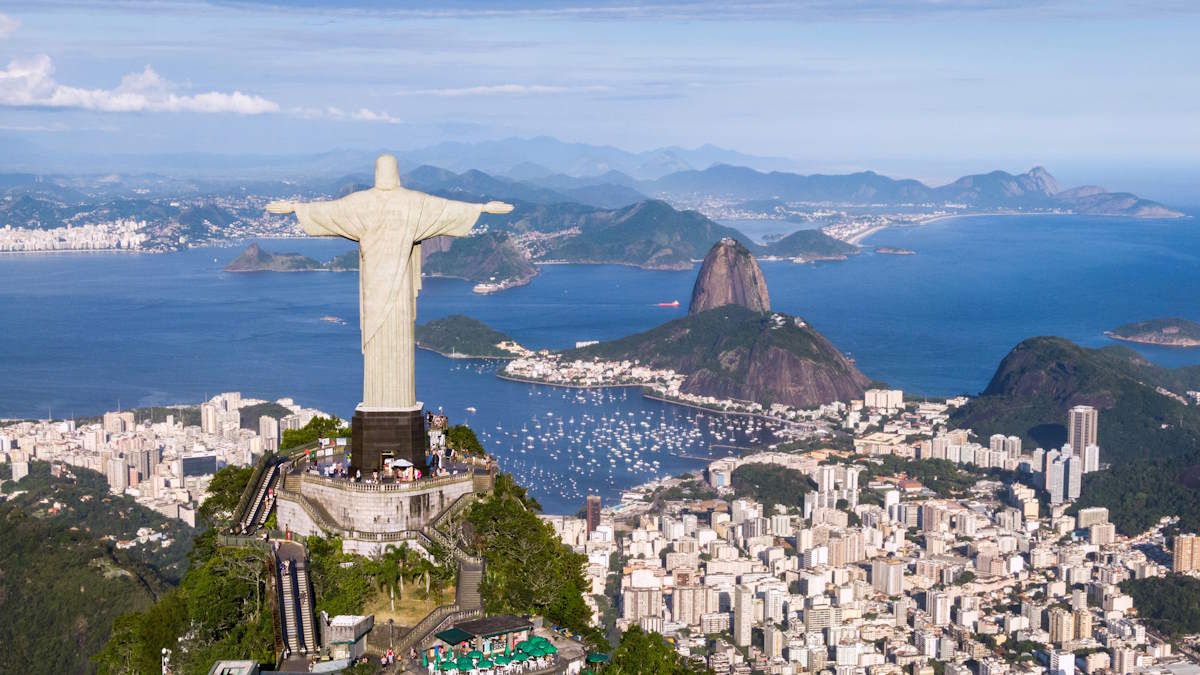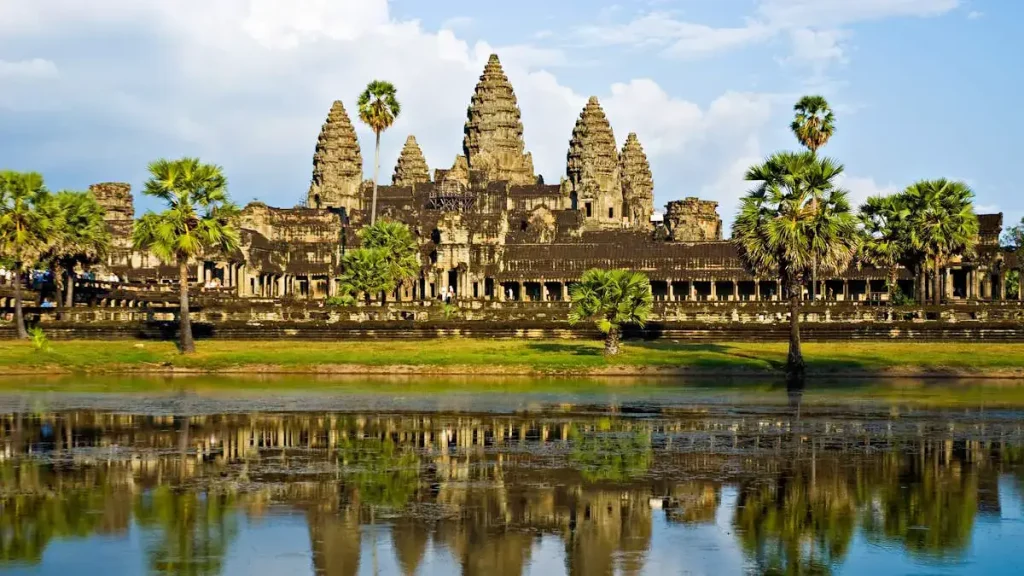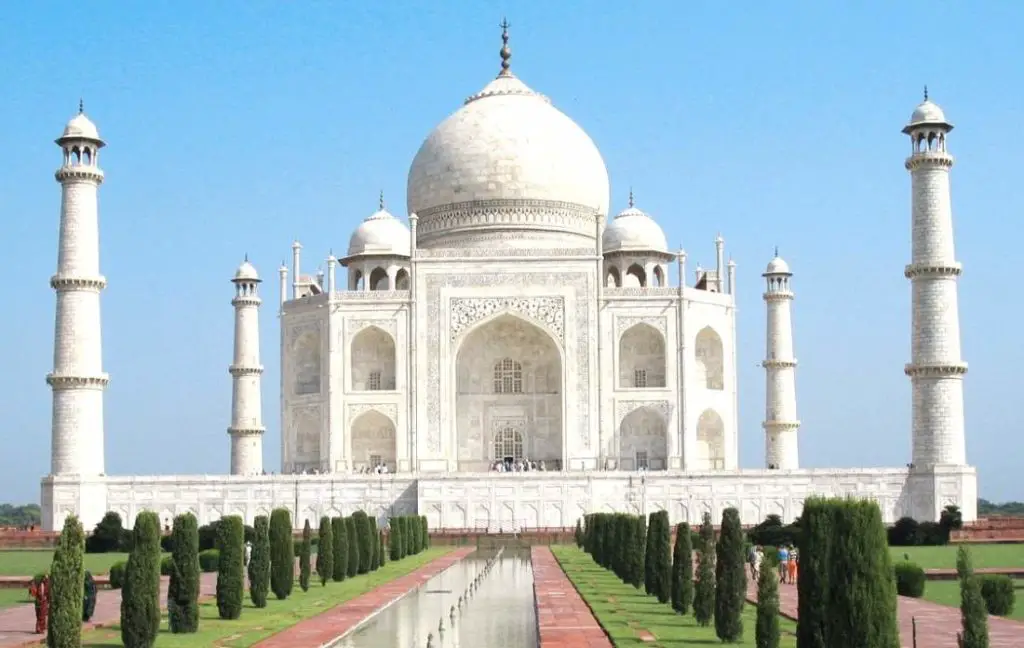The iconic Great Pyramid of Giza, also known as the Khufu’s Pyramid, stands alone as the sole survivor among the Seven Wonders of the Ancient World. Remarkably, there was a brief period, lasting less than 60 years, when all these monumental wonders coexisted. This fleeting overlap in history underscored the need for a modern tribute, leading to the launch of the New Seven Wonders of the World (New7Wonders) campaign in 2001. This initiative aimed to recognize and celebrate contemporary marvels, drawing from a diverse list of 200 existing architectural feats.
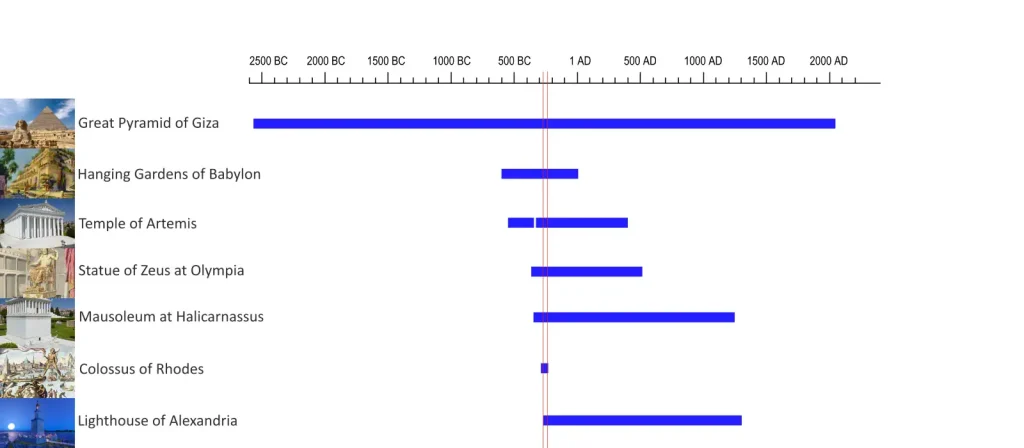
Spearheaded by the Zurich-based New7Wonders Foundation, the New Seven Wonders of the World initiative captured global attention. It empowered people to vote via the Internet and through select telephone polling to determine the most beloved modern wonders from a list of finalists. These winners now embody our planet’s multifaceted cultural heritage and stand as symbols of international unity and human achievement.
New Seven Wonders of the World
1. Great Wall of China
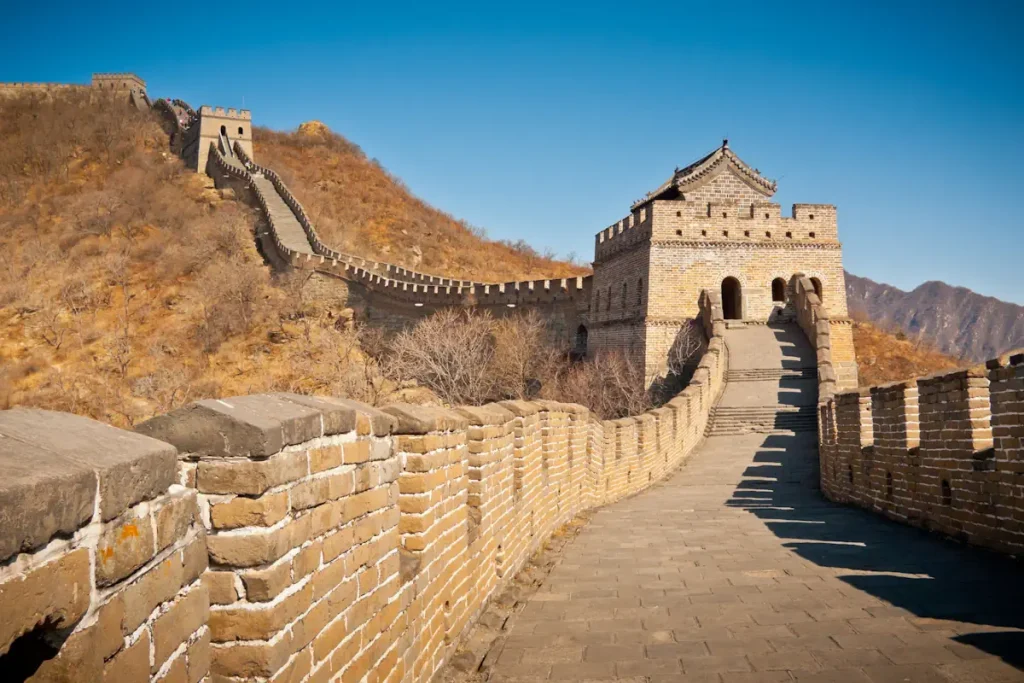
The Great Wall of China stands as a marvel of ancient engineering, an expansive fortification extending over 21,196 kilometers (about 13,171 miles). Built in stages from as early as the 7th century BC, with significant enhancements by the Ming Dynasty (1368-1644 AD), the Wall’s design was strategic, intended to protect the Chinese states against northern invasions. Contrary to common belief, the Wall is not one unbroken structure but rather a series of walls and barricades made from various materials that reflect the local terrain-ranging from stone and brick to tamped earth.
Its construction drew from a vast pool of workers, including soldiers and prisoners. Beyond defense, the Great Wall facilitated trade and border control along the Silk Road. Although it wasn’t impenetrable, as invaders did breach it on occasion, it stands as a symbol of enduring strength. Today, the sections that remain, some restored and others crumbling, are recognized as a UNESCO World Heritage Site and continue to be a potent draw for tourists around the globe. The most famous and well-maintained sections from the Ming era span roughly 8,850 kilometers (5,500 miles).
Contrary to popular belief, you cannot see the Great Wall of China from space.
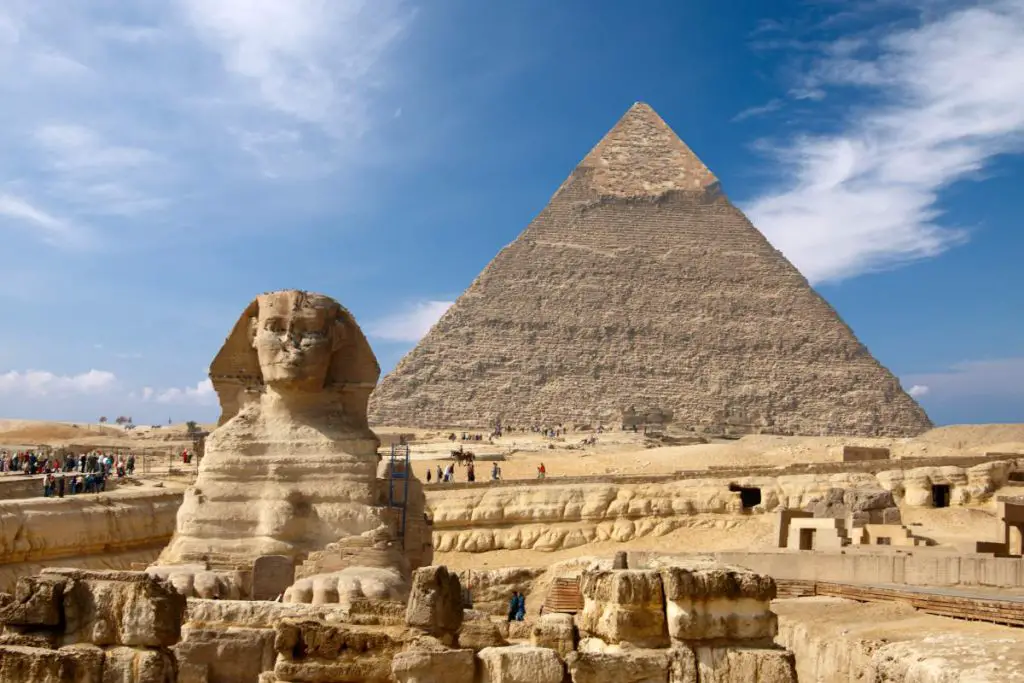
Related: Seven Wonders of the World
2. Petra [Jordan]
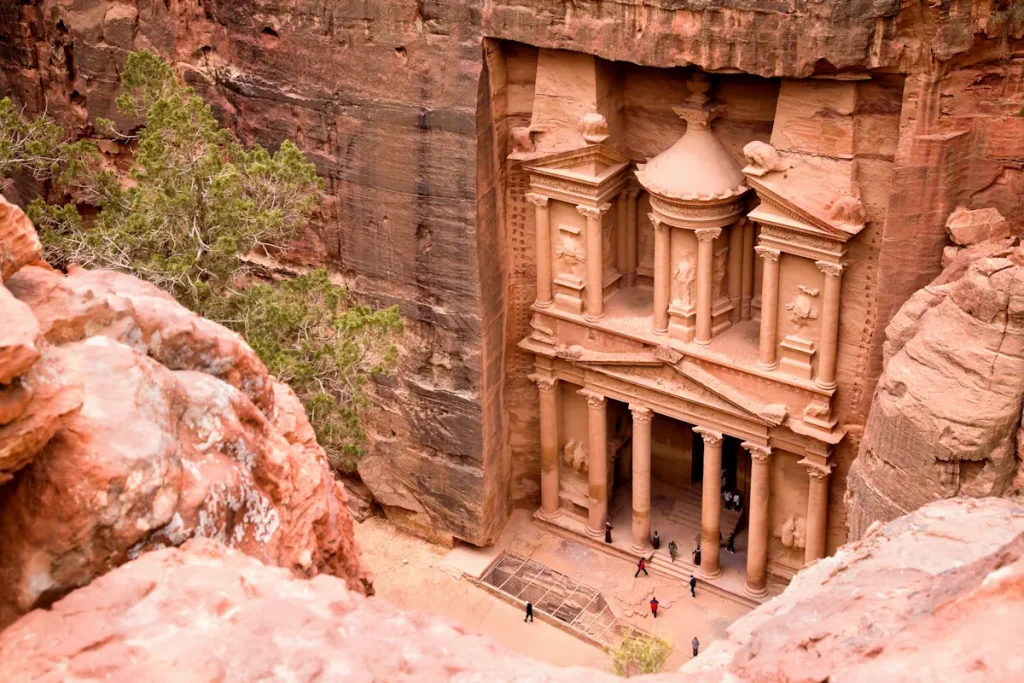
Petra, nestled in the heart of the mountainous desert of Jordan, is an archaeological and architectural wonder that was deservedly voted into the New Seven Wonders of the World in 2001. This ancient city, carved directly into vibrant red sandstone cliffs, was once the thriving capital of the Nabataean kingdom from around the 6th century B.C.
The site’s most iconic structure, Al-Khazneh – also known as the Treasury – greets visitors as they emerge from the narrow canyon called the Siq. Its elaborate façade, renowned for its Greek-influenced columns and intricate carvings, is thought to have been a mausoleum or a treasury. However, Petra is more than just the Treasury; it is a vast complex that includes tombs, temples, an amphitheater, and elaborate water channels, which are a testament to the Nabataeans’ advanced understanding of hydraulics.
Abandoned by the end of the Byzantine period, Petra was lost to the Western world until its rediscovery by Swiss explorer Johann Ludwig Burckhardt in 1812. This ‘lost city’ is not only significant for its architectural genius but also for its evidence of cultural exchange, having acted as a crucial trading hub that mingled Eastern traditions with Hellenistic architecture.
Today, Petra is Jordan’s most-visited tourist attraction, appreciated for its history, culture, and architecture. The mystique that envelops Petra, enhanced by its appearance in popular culture and films like “Indiana Jones and the Last Crusade,” adds to the allure that draws adventurers, academics, and tourists alike to this prehistoric city.
As a symbol of Jordan’s rich history, Petra continues to echo the ingenuity of its builders through the shadows of its awe-inspiring rock-cut façades.
Petra has been a UNESCO World Heritage Site since 1985.
3. Colosseum [Rome, Italy]
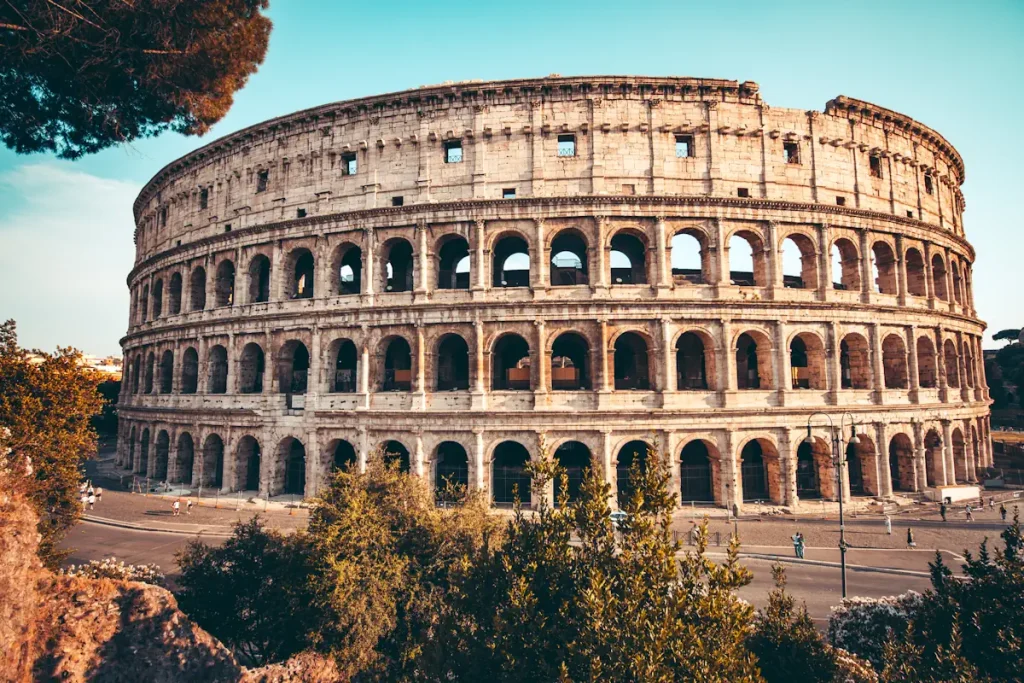
The Colosseum of Rome, an enduring icon of the Roman Empire’s grandeur, was selected as one of the New Seven Wonders of the World for its unparalleled architectural and historical significance. This colossal amphitheater, originally known as the Flavian Amphitheatre, was commissioned by Emperor Vespasian and completed by his son Titus in 80 A.D., with further modifications under Domitian. Its massive structure could hold an estimated 50,000 to 80,000 spectators who reveled in various public spectacles, including gladiator contests, animal hunts, and mock sea battles.
Constructed from concrete and sand, it is the largest amphitheater ever built and a testament to Roman engineering prowess. The Colosseum’s design, with its complex system of vaults, was so ahead of its time that it remains influential for stadium construction to this day. The structure has suffered extensive damage over the centuries due to natural disasters, neglect, and stone robbery, yet it still dominates the Roman landscape, reflecting the resilience and continued legacy of ancient Rome.
Beyond its architectural achievements, the Colosseum also stands as a symbol of the cultural and political might of the Roman Empire. It was a center for entertainment and a display of imperial power, where the populace could witness the might of Rome through the grandeur of its spectacles.
Today, the Colosseum is one of Italy’s most popular tourist attractions, drawing millions of visitors each year. Its inclusion in the New7Wonders acknowledges not just its past glory but also its current role as a link between the ancient and modern worlds, offering insight into a civilization that has profoundly influenced Western culture. Its very name evokes the might of historical Rome and the timeless allure of its civilization.
4. Chichen Itza [Mexico]
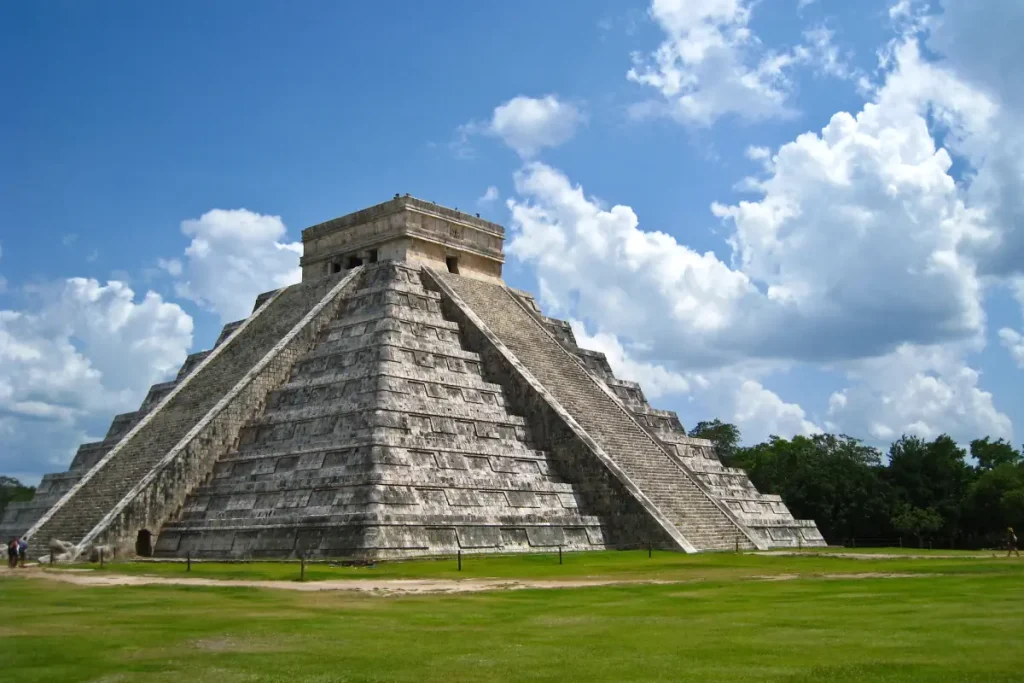
Chichen Itza, the majestic city of the ancient Maya civilization, proudly stands as one of the New Seven Wonders of the World, a testament to the astronomical precision and architectural genius of its builders. Located in the Yucatan Peninsula of Mexico, this large pre-Columbian archaeological site exhibits a variety of architectural styles, indicative of the diverse influences that converged in this city.
The most famous landmark within Chichen Itza is the Temple of Kukulcan, also known as El Castillo. This step pyramid marvel embodies the Maya’s astronomical expertise, as its design is synchronized with the solar calendar. Each of its four sides has 91 steps, which, when added to the temple platform on top, equal the 365 days of the solar year. Notably, during the spring and autumn equinoxes, shadows cast by the setting sun create the illusion of a serpent slithering down the staircase, which is said to represent Kukulcan, the feathered serpent god.
Chichen Itza served as a powerful urban center, a hub for regional trade, and a site for ceremonial activities. At its peak, it was a melting pot of Maya culture, showing Toltec influences, evident in the fusion of architectural designs and the depiction of Toltec warriors in the site’s reliefs.
Chichen Itza continues to be one of the most visited archaeological sites in Mexico, allowing millions of tourists to walk amid temples and ball courts, pondering the astronomical accuracy and sophisticated urban planning that characterized Maya civilization. Chichen Itza is not just a historical site but also a bridge that connects the intellectual achievements of the past with the curiosity and admiration of the present.
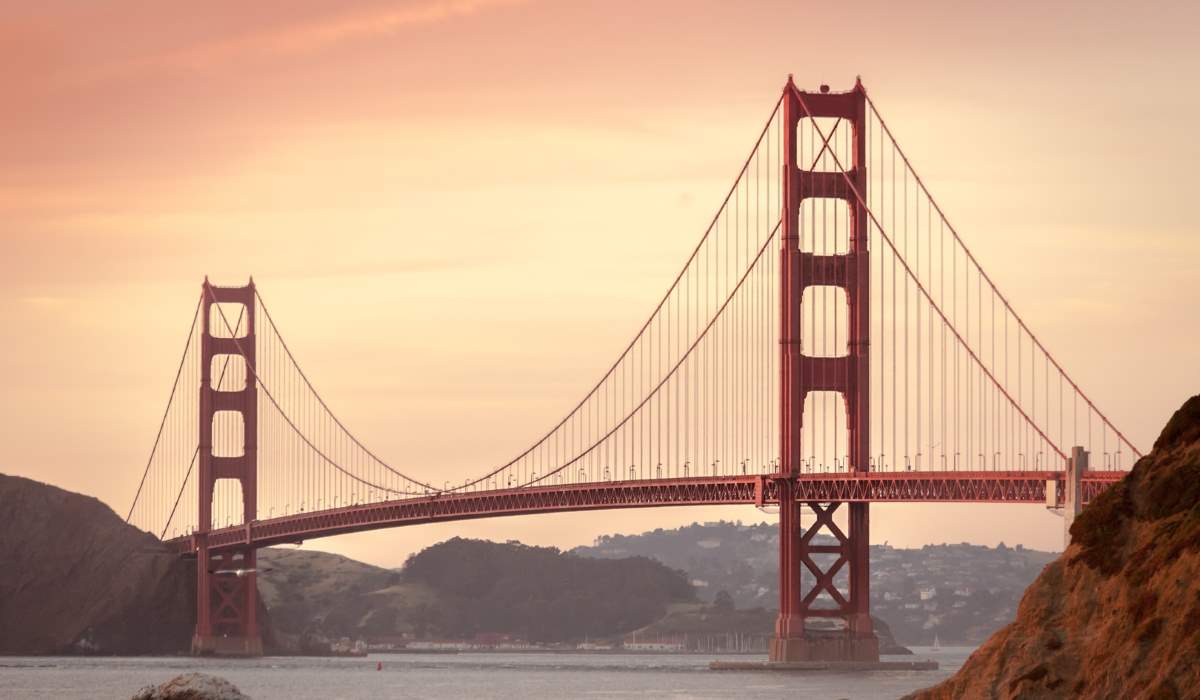
Related: Seven Wonders of the Modern World
5. Machu Picchu [Peru]
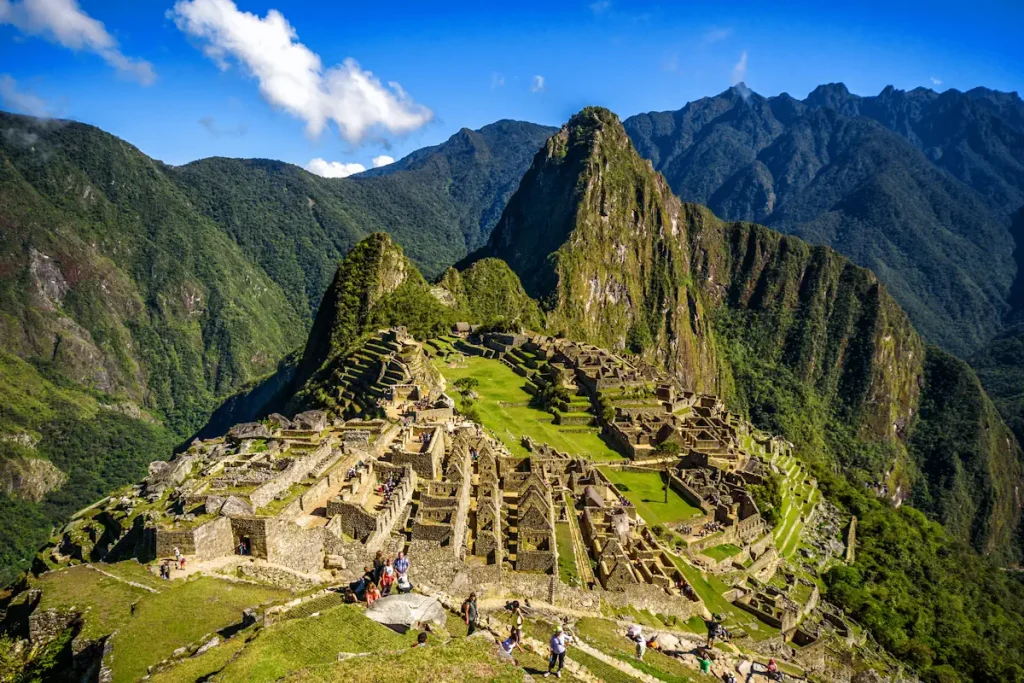
Machu Picchu, an ancient Incan citadel set high in the Andes Mountains of Peru, was rightfully chosen as one of the New Seven Wonders of the World, celebrating its profound historical and architectural significance. Perched above the Urubamba River valley at 2,430 meters (7,970 feet) above sea level, this awe-inspiring city was constructed in the 15th century under the reign of Emperor Pachacuti.
Enclosed by steep cliffs and with a backdrop of towering Andean peaks, Machu Picchu is a stunning testament to the Incan Empire at the height of its power and achievement. The site is divided into two main areas: the agricultural sector, with its vast terraces, and the urban sector, featuring temples, squares, and royal tombs meticulously carved from the mountain’s stone.
The central buildings of Machu Picchu use the classical Inca architectural style of polished dry-stone walls, with the most significant structure being the Intihuatana stone, a ritual stone associated with astronomical observations. Its purpose remains a subject of speculation, but its precision as a solar marker is undeniable, highlighting the Incas’ astronomical knowledge.
Machu Picchu remained unknown to the outside world until American historian Hiram Bingham brought it to international attention in 1911. Since then, it has become an emblem of the Incan legacy and a magnet for tourists globally, offering a window into the lives of the elite Inca class, their ingenuity, and their respect for their natural surroundings.
Machu Picchu is not only a sacred archaeological treasure but also a symbol of the harmonious relationship between human civilization and the environment. It continues to captivate the minds of those who climb its ancient pathways, providing a tangible connection to the Incan world and its mysteries.
Machu Picchu was declared a Peruvian Historic Sanctuary in 1981 and a World Heritage Site by UNESCO in 1983.
6. Taj Mahal [India]
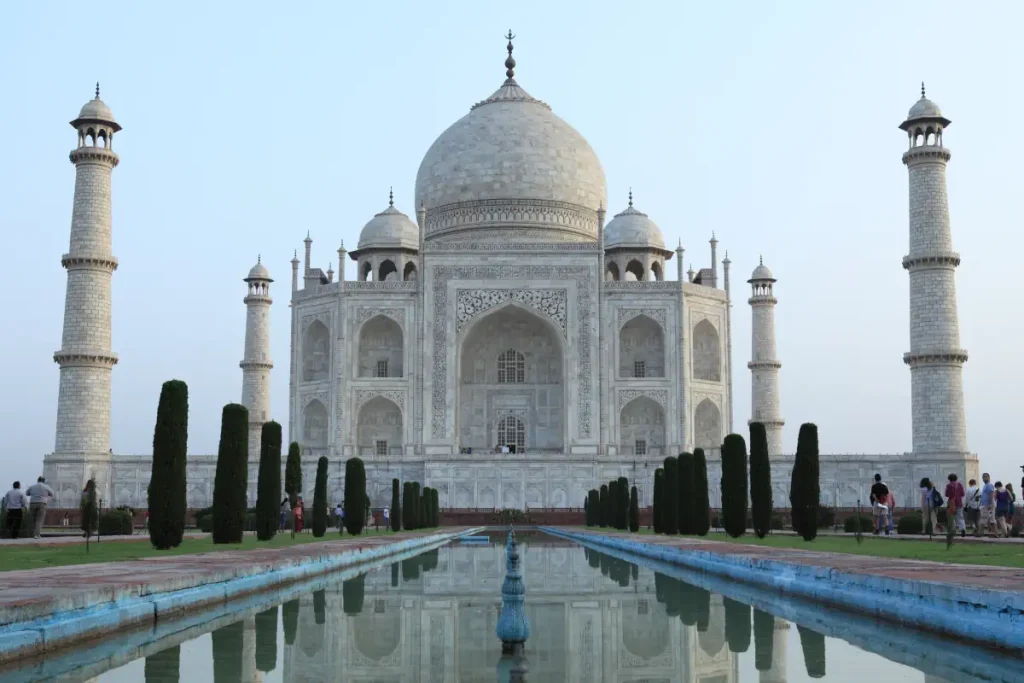
Designated as a UNESCO World Heritage Site in 1983 for being “the jewel of Muslim art in India and one of the universally admired masterpieces of the world’s heritage”, the Taj Mahal (Persian for Crown of Palaces) is an ivory-white marble mausoleum on the south bank of the Yamuna river in the Indian city of Agra. It was commissioned in 1632 by the Mughal emperor, Shah Jahan (reigned 1628-1658), to house the tomb of his favorite wife, Mumtaz Mahal.
This architectural jewel represents the zenith of Mughal architecture, combining elements from Islamic, Persian, Ottoman Turkish, and Indian architectural styles. Its centerpiece is the tomb itself, with a striking dome and four slender minarets that create a stunningly symmetrical sight from every angle. The complex also includes a mosque, a guest house, and the main gateway, all set within beautiful gardens that use the traditional char bagh or four-part garden layout, which symbolizes the gardens of paradise.
Inlaid with precious and semi-precious stones, the white marble of the Taj Mahal exudes a radiant glow that appears to change color depending on the time of day, enchantingly reflecting the mood of the sky. The intricate calligraphy and detailed reliefs on its walls recite verses from the Quran and enhance its spiritual and solemn ambiance.
7. Christ the Redeemer [Brazil]

Christ the Redeemer, the towering statue of Jesus Christ in Rio de Janeiro, Brazil, stands as one of the New Seven Wonders of the World, exemplifying spiritual symbolism and architectural prowess. This monumental sculpture, perched atop the 700-meter-high (2,300 feet) Corcovado mountain in the Tijuca Forest National Park, overlooks the city with outstretched arms, fostering a sense of protection and peace.
Crafted between 1922 and 1931, the statue is the work of Brazilian engineer Heitor da Silva Costa, French sculptor Paul Landowski, and Romanian artist Gheorghe Leonida, who designed the face. Made of reinforced concrete and soapstone, which are both durable and suitable for the statue’s exterior, Christ the Redeemer stands 30 meters (98 feet) tall, not including its 8-meter (26-foot) pedestal, with arms stretching 28 meters (92 feet) wide. This majestic size makes it one of the largest Art Deco-style sculptures in the world.
The statue’s construction was intended as a symbol of Brazilian Christianity and as a gesture of peace, coinciding with the 100th anniversary of Brazil’s independence. It has since become a cultural icon of both Rio de Janeiro and Brazil, visible from almost every part of the city and serving as a beacon for all who visit.
The inclusion of Christ the Redeemer in the New Seven Wonders was a recognition of its status as a global symbol of Christian faith and an expression of human creativity, bridging the gap between art and engineering. Today, it is not only a place of pilgrimage for believers but also a magnet for tourists from around the world, offering breathtaking panoramic views of Rio de Janeiro and serving as a reminder of humanity’s potential for greatness.
Other finalists of the New Seven Wonders of the World campaign
The other 13 finalists of the New Seven Wonders of the World campaign, chronologically were:
- Stonehenge – Amesbury, United Kingdom – 2400 BC
- Acropolis of Athens – Athens, Greece – 447 BC
- Hagia Sophia – İstanbul, Turkey – 537
- Angkor Wat – Angkor, Cambodia – 1113
- Moai – Easter Island, Chile – 1250
- Timbuktu – Timbuktu, Mali – – 1327
- Alhambra – Granada, Spain – 1333
- Red Square – Moscow, Russia – 1561
- Kiyomizu-dera – Kyoto, Japan – 1633
- Neuschwanstein – Füssen, Germany – 1869
- Statue of Liberty – New York City, United States – 1886
- Eiffel Tower – Paris, France – 1887
- Sydney Opera House – Sydney, Australia – 1959
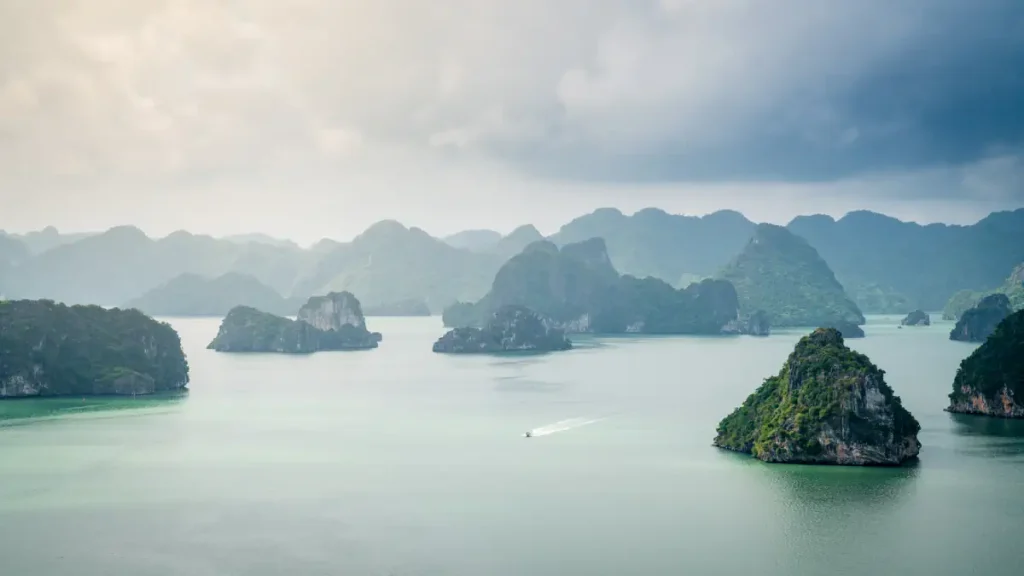
Related: New 7 Wonders of Nature
Notes
- Hieronymus of Cardia was a Greek general and historian from Cardia in Thrace, and a contemporary of Alexander the Great (356-323 BC).
- Art Deco, also called style moderne, is a style of visual arts, architecture, and design that first appeared in France just before World War I. Art Deco design represented modernism turned into fashion. Its products included both individually crafted luxury items and mass-produced wares, but, in either case, the intention was to create a sleek and anti-traditional elegance that symbolized wealth and sophistication.
Sources
- New Seven Wonders of the World (New7Wonders of the World) on Wikipedia
- Great Wall of China on Wikipedia
- Colosseum on Wikipedia
- Chichen Itza on Wikipedia
- Machu Picchu on Wikipedia
- Christ the Redeemer on Wikipedia
- Art Deco on Wikipedia
- Art Deco on the Britannica
- Moon Landings: All-Time List [1966-2025] - February 2, 2025
- What Is Max-Q and Why Is It Important During Rocket Launches? - January 16, 2025
- Top 10 Tallest Rockets Ever Launched [2025 Update] - January 16, 2025
